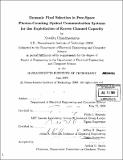Dynamic pixel selection in free-space photon-counting optical communication systems for the exploitation of excess channel capacity
Author(s)
Chandrasekaran, Nivedita
DownloadFull printable version (39.36Mb)
Other Contributors
Massachusetts Institute of Technology. Dept. of Electrical Engineering and Computer Science.
Advisor
Pablo I. Hopman.
Terms of use
Metadata
Show full item recordAbstract
Atmospheric turbulence in free-space optical communications turns signal demodulation and decoding into a multimode problem as wavefronts of the transmitting laser beams are warped spatially past the desired form of a diffraction-limited spot at the receiver end of a free-space optical receiver. Adaptive optics, a traditional solution to this problem, is computationally expensive and adds complexity to receiver architecture by requiring tools like wavefront sensors and deformable mirrors. Due to the enabling technology of Geiger-mode avalanche photodiode (GM-APD) arrays, a simple algorithm that only requires information from the GM-APD array to implement the technique of dynamic pixel selection can be realized entirely in software or firmware. Dynamic pixel selection exploits the temporal and spatial information attached to each received photon by filtering out noisy or otherwise undesirable portions of the array in order to exploit any excess channel capacity in the link to allow on-the-fly adjustments of data rates. Preliminary results, specific to the MIT Lincoln Laboratory photon-counting, free-space optical communication system, which utilizes an 8 x 8 GM-APD receiver array, operates at a 1.06pm wavelength with 16-PPM signaling, and supports data rates up to 10 Mbps over 1-5km long paths, will be discussed.
Description
Thesis (M. Eng.)--Massachusetts Institute of Technology, Dept. of Electrical Engineering and Computer Science, 2009. Includes bibliographical references (p. 111-112).
Date issued
2009Department
Massachusetts Institute of Technology. Department of Electrical Engineering and Computer SciencePublisher
Massachusetts Institute of Technology
Keywords
Electrical Engineering and Computer Science.